KIN 216 - Angular Kinematics
1/82
There's no tags or description
Looks like no tags are added yet.
Name | Mastery | Learn | Test | Matching | Spaced |
|---|
No study sessions yet.
83 Terms
what is general motion?
a combination of linear and angular motion
what is linear motion?
translation
change in position
move in the same direction
describing changes in position in space
what is angular motion?
rotation
change in orientation
spin around the same fixed axis
describing rotation in space
when does angular motion occur?
when a body moves along a circular path, revolving around a central line or point
angular motion can also be referred to as…?
rotation
what are the three types of angular movements or rotations?
ypr
yaw
pitch
roll
how many types of linear and angluar movements?
linear: 2; rectilinear and curvilinear
angular: 3; ypr
what is yaw?
rotating to the left or right
what is pitch?
rotating up or down
what is roll?
tilting to the left or right
unlike translation, angular motion keeps a fixed point called… ?
the axis of rotation
what is an external axis of rotation?
an imaginary line found outside of the body
system moves in a circular path around the axis (ex. giants around a bar; where the bar is the external axis of rotation)

what is an internal axis of rotation?
imaginary line found inside of the body
system moves in a circular path around the axis (ex. hip joint when running/walking; where hip joint is the internal axis of rotation)

what is the standard reference position of the human body called? what does it look like?
the anotomical position
body is erect
facing forward
feet aligned parallel to each other
toes forward
arms hanging straight below shoulders
fingers extended
palms facing forward
the anatomical position is used when describing what of the body?
lpm
locations
positions
movements
what is a cardinal planes?
a plane that passes through the midpoint or center of gravity of the body
cardinal planes may be useful for ?
locating anatomical structures
describing limb movements
body movements occur as… ?
rotations of the limbs
rotation occur around what and within what?
rotations occur around an axes and within specific planes
what movement is yaw and what axis does it rotate around?
yaw is turn to left or right (ex. saying no)
to rotate around a longitudinal (vertical) axis
what movement is pitch and what axis does it rotate around?
to look up or down (ex. saying yes)
to rotate around a mediolateral (a line running from side-to-side) axis
what movement is a roll and what axis does it rotate around?
tilting the head to the left or right shoulder
rotating around an anterioposterior axis
the direction of the axis of rotation is found perpendicular to
the plane of motion
what plane corresponds with the longitudinal axis? and what movements would occur in this plane?
the transverse (horizontal) plane
medial/lateral rotation, YAW

what plane corresponds with the mediolateral axis? and what movements occur in this plane?
the sagittal plane
flexion/extension, hyperextension, PITCH
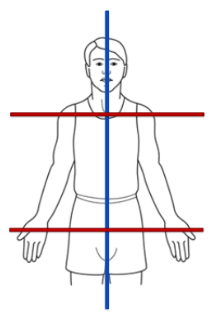
what plane corresponds to the anterioposterior axis? and what movements would occur in this plane?
the frontal plane
abduction/adduction, elevation/depression, lateral flexion, ROLL
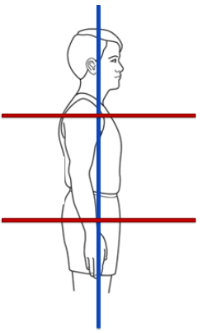
what is the instant centre?
where the movement is coming from
what information do we first require when measuring angular movement?
identify the location of three joint centers of rotation (instant center)
identify the orientation of the two logitudinal segments
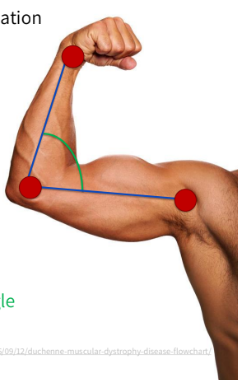
3 joint centers and 2 longitudinal segments will identify what?
1 joint angle
what is a relative angle?
the space between the longitudinal axes of adjacent segments. can be:
internal
external
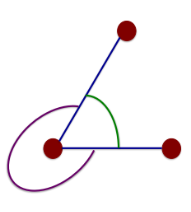
what is the internal angle
the angle formed inside the joint
what is the external angle
the angle formed on the exterior surface of the joint
what is an absolute angle?
the space between a body segment with respect to a fixed line of reference
can be between the longitudinal segment and EITHER the x- or y- axes

what is a degree?
a common method for measuring angles
arbituary unit of measurment
useful to ancient astronomers
once around the circle is 0degrees to 360degrees
what is a revolution?
simple and natural measurment
once around the circle
1 full turn
what is a radian?
equal to 57.3degrees
invented in the 1700s by mathematicians who wanted to define angles rationally
a ratio between the angle in a circle and the length of the arc
where the arc length is equal to the radius
what do radians take into account?
take Pi into account
Pi = 3.14
which of the following is the standard unit of measure for angular variables when measuring human movement?
a) degrees
b) radians
c) revolutions
d) all of the above
all of the above (degrees, radians, and revolutions) are acceptable units of measure
360 degrees is equal to how many revolutions?
1 revolution
1 revolution is equal to how many radians?
2Pi rad
2Pi rad is equal to how many degrees?
360 degrees
how many degrees is in one rad?
57.3 degrees
what is a goniometer? in what profession is it widely used and why?
an instrument that measures an angle
widely used in physical therapy to assess range of motion before and after intervention (tracking progress over time)
(gonia-angle) (metron-measure)
what is a basic goniometer useful for?
static analysis
angles in pictures
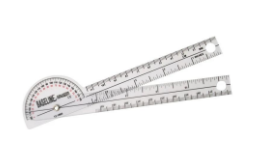
what is an electrogoniometer useful for?
dynamic analysis
taking measurements during movement
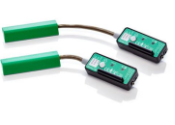
what is different about measuring body angles when compared to angles such as a moving door, for example?
a door rotates in a fixed position around a hinge; the axis of rotation is usually in a fixed position
in the body, the axis of rotation at a joint is not fixed; the longitudinal segment shifts position because the axis migrates

how can you be certain of the precise location of the origine of movement (instant center)?
you cant! haha
when analyzing human movements, we estimate the position of the axis of rotation
what is angular distance?
phi
the total amount of rotation - scalar quantity
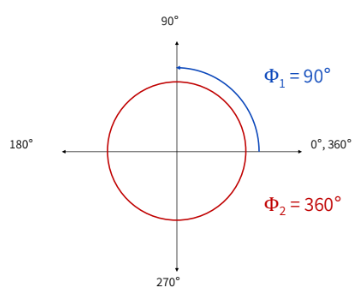
what is angular displacement?
theta
the change in angular position - vector quantity
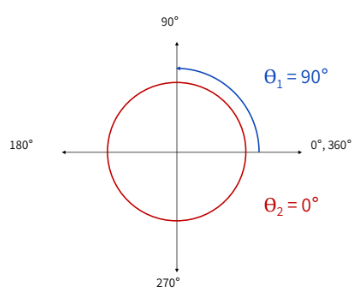
what do we use to describe the objects position in space?
phi - angular distance (scalar)
theta - angular displacement (vector)
what do we use to decribe the temporal patterns of movement?
sigma - angular speed (scalar)
omega - angular velocity (vector)
what is angular speed?
sigma
change in angular distance (phi) over a change in time - scalar quantity
what is angular velocity
omega
change in angular displacement (theta) over a change in time - vector quantity
what is dynamic motion characterized by?
dynamic motion is characterized by a change in angular velocity
what producs a change in angular velocity?
torque
what is angular acceleration
alpha
change in angular velocity (omega) over a change in time
what do the signs in front of the displacement and velocity values tell us about human movement?
positive values mean that the system is rotating counter-clockwise
negative values tell us that the system is rotating clockwise
what does the sign in front of acceleration value mean?
you dont know! because it could either be:
the direction
OR
weather the system is speeding up or slowing down
further detail (context) is necessary to answer this question
angular kinematics in the everyday can helps with what?
angular kinematics will help you position your body in a safe and comfortable angle
can help decrease risk for carpal tunnel
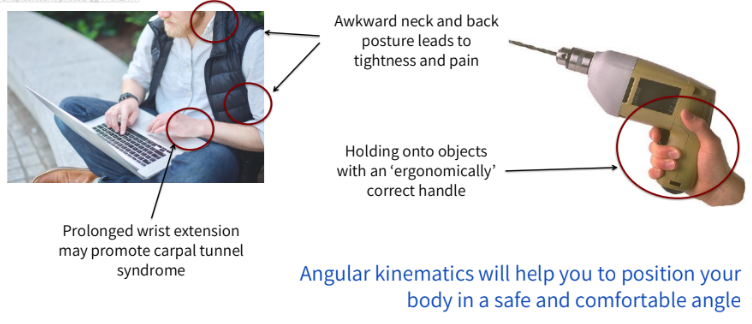
most examples of human movement are:
general motion (both)
we could analyze the rotation at the joints
we could analyze the translation of the limbs
what is the relationship between the two forms of motion (rotation and translation)?
the more the ball spins the further the ball travels
the faster the ball rotates the faster the ball translates

if this line segment was to represent ur arm, what part is the axis of rotation? and what part is translating?
the blue part would be the axis of rotation (the origin of motion) at your shoulder
the red and green parts would represent your elbow and hand respectively. as the arm swings back and forth, they each change position (or translate)
the linear change in position on a rotating object will be different where? what is this dependant on?
at EACH point along the system
the amount of change is dependant upon the radius of rotation
what is the radius of rotation (r)?
the distance between the axis of rotation and the point of interest on a system
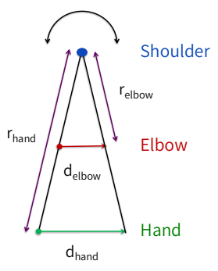
what equation is used for determining how far a point on that system translates when a system rotates about an axis?
length = radius of rotation x angular distance (phi)
what equation is used for determining how fast a point on a system translates when a system rotates about an axis?
velocity = radius of rotation x angular velocity
what equation is used for determining the size of the dynamic change when a system rotates about an axis?
acceleration = radius of rotation x angular speed
why do we use linear and distance (scalar quantities) and also velocity and acceleration (vector quantities)?
measuring displacement, a change in position, would underestimate how far a system has moved
in order to account for angular movement, we take into account the total amount of linear movement (distance), not the displacement
a radian is the ratio of the distance around the circle to the radius of the circle

why does a batter “choke up” (slide their hands away from the handle)?
if distance is not a factor — and the athlete just wants to ensure they make contact with the ball, players will often grab up on the bat to improve accuracy by decreasing the radius of rotation; as velocity decreases, accuracy increases
why does a batter “choke down” (slide their hands as low on the bat as possible)?
in order to hit as far as possible (1/2mv²) - as fast as they can, they grab on to the end of the bat to increase the radius of rotation so that velocity is increased.
the direction of the linear movement is _______ to the rotating object
tangent.
if the ball spins in a clockwise direction the ball would translate to the right” etc.
tangentional
reminds you that there was an angular movement that gave rise to a linear change
both formulas for tangentional velocity and linear velocity do what? why
solve for linear velocity
tangentional velocity takes into acount angular velocity which is important when discussing centripital motion: if an object is moving around a curve at a constant speed, even though its magnitude of velocity isn’t changing, its direction (sign) changes through the different points; i.e. if velocity is changing then acceleration is present (even though its moving with a constant speed)
a point on an opject spinning at a constant velocity is constantly changing _____ and is experiencing ______________.
direction, linear acceleration (centripital acceleration)
centripital (or radial) acceleration is present when…?
when an object changes direction
where is the force that causes centripetal acceleration to occur directed?
it is directed towards the axis of rotation, this force causes a change in direction
ar = v²/r
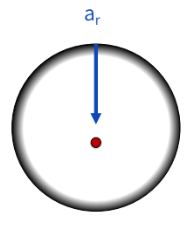
what is centripital acceleration?
the linear acceleration directed towards the axis of rotation
ar = v²/r
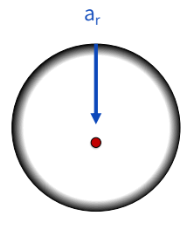
what is the relationship between the radius of rotation, force, and turn velocity
ar = v²/r
ar increases as radius of rotation decreases; more force would be required to make a sharper turn
ar increases as velocity increases; more force would be required to make a faster turn
as the sharpness of turn increases, the velocity must decrease
when competing a 400 meter race, is there one lane that offers a biomechanical advantage?
the outside because, with a larger radius of rotation, velocity increases
what is the total acceleration of a system?
the vector sum of the tangentional acceleration and the centripetal acceleration
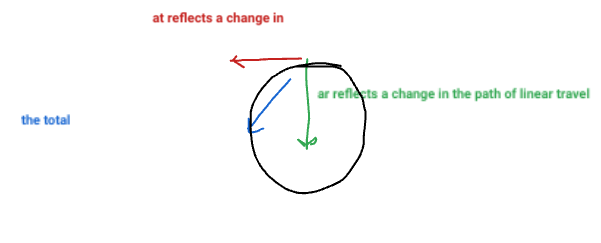
what is the relationship between the lengths of golf clubs and the distance they can hit
the longest club is the driver and the shortest club is the pitching wedge
even with the same movement input, drivers hit the ball farther than the pitching wedge
what is the importance of stretching our joints before exercise?
stretching increases range of motion at a joint.
a greater rage-of-motion (angular displacement; linear displacement is related to the amount of angular rotation) will affect both linear and angular changes — leading to improved performance
there is a non-linear relationship between which linear and angular variables when it comes to what?
internal movements; movements inside the human body
linear changes occur at the muscle
Angular changes occur at the joint
THERE IS A NONLINEAR RELATIONSHIP BETWEEN VELOCITY AND ANGULAR VELOCITY